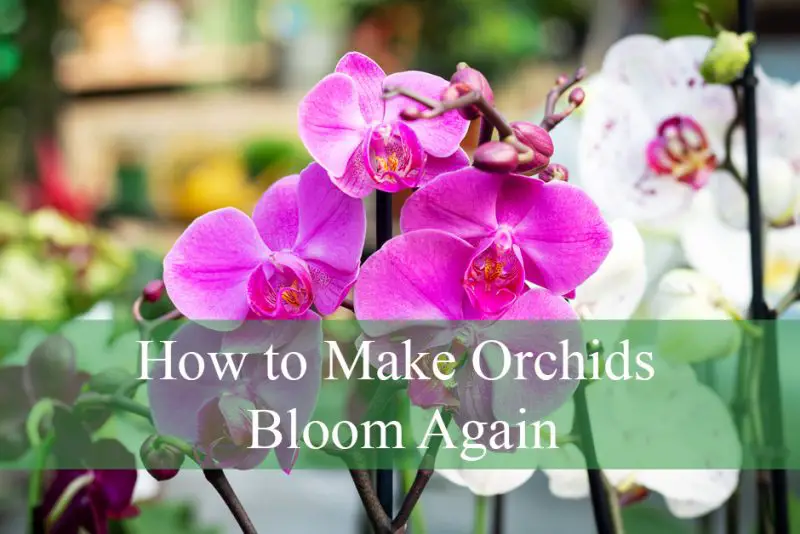Orchids are among the most captivating and exotic flowers commonly grown indoors. Their intricate shapes, vibrant colors, and long-lasting blooms make them a favorite among houseplant enthusiasts.
However, many orchid owners find themselves confused or disappointed when their plant suddenly stops blooming. Even when the leaves look healthy and the roots seem fine, the absence of flowers can be frustrating.
If your orchid is no longer producing blooms, don’t worry—it doesn’t mean the plant is done flowering for good. With the right care and a bit of patience, you can encourage it to rebloom. This step-by-step guide will show you exactly how to do that.
Understanding Orchid Bloom Cycles

Orchids follow a natural life cycle that includes distinct blooming and resting phases. After showcasing their stunning flowers, orchids transition into a resting or dormant stage. This period isn’t a sign of decline; rather, it’s a critical recovery time where the plant conserves energy, strengthens its root system, and prepares for the next bloom. Ignoring or misunderstanding this cycle can lead to over-care, which may do more harm than good.
The length of the dormant phase varies depending on the orchid species. For instance, Phalaenopsis orchids, also known as moth orchids, usually bloom once or twice per year. Their dormancy typically lasts a few weeks to a few months. Other types, such as Cattleya or Dendrobium, may have different blooming schedules and longer resting periods. During this time, the orchid may stop producing flowers, and growth may seem to slow, but important internal processes are still underway.
Understanding when your orchid is resting helps you avoid common mistakes like overwatering, repotting too soon, or applying fertilizer too frequently. These actions, if done during dormancy, can stress the plant and potentially rot its roots. Observing your orchid closely—watching for signs like faded blooms, firm green leaves, and healthy roots—can help you recognize the resting phase and support the plant properly until it’s ready to bloom again.
Step 1: Identify Your Orchid Type
The journey to encouraging your orchid to rebloom begins with identifying its type. Orchids are an incredibly diverse group of plants, and each species or hybrid comes with its own set of care requirements, preferred environmental conditions, and blooming cycles. Understanding what kind of orchid you have is crucial, as it allows you to provide the specific care it needs during both its growing and resting phases.
One of the most popular and beginner-friendly orchids is the Phalaenopsis, commonly known as the moth orchid. These orchids typically bloom once or twice a year and are well-known for their ease of reblooming under the right conditions. Their broad, flat leaves and long arching flower spikes make them a familiar sight in many homes and nurseries.
Other orchid types have different requirements. Cattleya orchids, for example, are known for their large, showy flowers and tend to bloom once a year, usually in response to changes in light or temperature. Dendrobium orchids are more diverse and fall into several sub-groups, with some varieties needing a distinct dry rest period in winter to stimulate blooming. Oncidium orchids, often called “dancing ladies,” require bright light and high humidity to flower again successfully. By accurately identifying your orchid, you can adjust your care strategy to match its natural bloom cycle, giving it the best chance to flower again.
Step 2: Prune the Flower Spike
Once your orchid has finished blooming, the next important step is to examine the flower spike—the stalk from which the blooms emerged. This evaluation helps you determine whether to prune it partially or remove it entirely, depending on the spike’s condition. Pruning not only tidies the plant’s appearance but also redirects its energy toward future growth and potential reblooming.
For Phalaenopsis orchids, if the flower spike remains green and firm after the flowers fall off, it may still be viable. In this case, you can trim the spike just above a visible node, which looks like a small bump along the stem. Cutting just above a node can sometimes trigger the development of a secondary spike or encourage new blooms to form from that point. This method offers a chance for faster reblooming without waiting for an entirely new spike to grow.
However, if the spike has turned brown, yellow, or dry, it’s no longer active. In such cases, it’s best to cut it all the way down to the base of the plant. Removing a spent or dead spike allows the orchid to channel its resources into strengthening its leaves and root system. This recovery is essential for building up the energy reserves needed to support the next bloom cycle. Proper pruning supports the orchid’s natural rhythms and keeps the plant healthy and prepared for future flowering.
Step 3: Adjust Lighting Conditions
Light plays a vital role in an orchid’s ability to rebloom. While orchids are adapted to receive filtered light in their natural habitats—such as through tree canopies—they still need plenty of bright, indirect light to trigger the blooming process. When an orchid receives too little light, it may remain healthy in appearance but will not produce new flower spikes.
One of the easiest ways to tell if your orchid is getting enough light is by observing the color of its leaves. Dark green leaves often indicate that the plant is not receiving sufficient light. While the foliage may look lush, the orchid may not have the energy to initiate blooming. In contrast, light to medium green leaves are a sign of optimal lighting conditions. This subtle color difference can help you fine-tune your orchid’s placement to encourage healthy growth and flower production.
To improve lighting, position your orchid near an east-facing window where it can receive gentle morning sunlight. A south-facing window also works well, especially during the winter months, though you may need to filter the light with a sheer curtain to prevent scorching. If natural sunlight is limited—especially in darker seasons or in low-light homes—supplemental grow lights can provide the consistent illumination orchids need. Ensuring proper lighting is one of the most effective steps you can take to promote reblooming.
Step 4: Maintain Proper Temperature
Temperature plays a key role in signaling to orchids that it’s time to bloom. Many orchids, especially Phalaenopsis, rely on subtle shifts in temperature to initiate flower spike development. Mimicking the temperature fluctuations found in their natural environment can effectively encourage the plant to transition from its resting phase to a blooming phase.
For most commonly grown orchids, the ideal daytime temperature range is between 65–75°F (18–24°C). At night, they prefer slightly cooler conditions, typically 55–65°F (13–18°C). These cooler nighttime temperatures are especially important for triggering reblooming in Phalaenopsis orchids. The contrast between warm days and cooler nights stimulates hormonal changes that lead to the growth of new flower spikes.
To promote blooming, try exposing your orchid to a temperature drop of about 10°F (5°C) at night for a period of one to two weeks. This can be done by placing the plant near a slightly open window during cool evenings or moving it to a cooler room at night. Be sure to avoid extreme cold drafts or temperatures below 50°F (10°C), as these can harm the plant. With the right balance of warmth and gentle cooling, your orchid will receive the natural cue it needs to bloom again.
Step 5: Optimize Watering Schedule
Proper watering is essential for encouraging your orchid to bloom again. Orchids are particularly sensitive to their moisture levels, and both overwatering and underwatering can prevent blooming or even damage the plant. Striking the right balance will help keep your orchid healthy and capable of producing new flower spikes.
Orchids typically prefer to be watered when the potting medium is nearly dry but not completely bone-dry. This usually translates to watering every 7 to 10 days, though frequency can vary depending on temperature, humidity, and the type of potting mix used. The best way to check if your orchid needs water is by feeling the growing medium with your finger—if it feels just barely moist, it’s time to water.
When watering, it’s important to do so thoroughly. Allow water to run through the entire pot, making sure it drains completely from the bottom. Avoid letting the pot sit in any standing water, as this can quickly lead to root rot, one of the most common problems among orchid growers. At the same time, don’t let the roots dry out entirely for extended periods, as this can stress the plant and reduce its ability to bloom. By maintaining a consistent and appropriate watering schedule, you’ll support healthy root development and set the stage for successful reblooming.
Step 6: Use the Right Fertilizer
Fertilizing your orchid correctly is another important step in encouraging it to bloom again. Orchids require essential nutrients to support both vegetative growth and flower production. Using the right type and amount of fertilizer at the proper time can greatly enhance your orchid’s ability to rebloom.
During the active growing season—typically spring through summer—feed your orchid every 2 to 4 weeks with a balanced fertilizer, such as one with a 20-20-20 ratio, or a product specifically formulated for orchids. These balanced nutrients support healthy leaves and roots, preparing the plant for future flowering. As your orchid nears its blooming phase, you can switch to a “bloom booster” fertilizer, which is higher in phosphorus. This nutrient helps stimulate flower spike development and encourages more vibrant and long-lasting blooms.
To avoid damaging your orchid’s sensitive roots, always dilute the fertilizer to half strength compared to the label’s recommendation. Over-fertilizing can lead to salt buildup and root burn, which hinders growth and blooming. It’s also important to reduce feeding frequency during the orchid’s rest period, usually in the cooler months. By tailoring your fertilizing routine to your orchid’s growth cycle, you’ll provide the support it needs to bloom beautifully once again.
Step 7: Repot If Necessary
Repotting your orchid is an important step that can significantly impact its ability to rebloom. Most orchids benefit from being repotted every 1 to 2 years, primarily because the potting medium—usually bark or sphagnum moss—breaks down over time. As it decomposes, it loses its ability to drain properly and provide adequate airflow to the roots, which are essential for healthy growth.
There are several signs that indicate your orchid may need repotting. If the potting medium has developed a sour smell or feels mushy, it means the roots are likely sitting in moisture for too long, which can cause root rot. Another sign is when the roots become overcrowded or start circling inside the pot, restricting their growth. Additionally, if your orchid is showing no new root or leaf growth, it might be struggling due to poor root conditions.
Repotting gives your orchid fresh growing medium and more space for its roots to spread. This encourages robust root development, which is crucial for the plant’s overall health and its ability to support future blooms. When repotting, choose a well-draining orchid mix and a pot with adequate drainage holes to maintain the right moisture balance and airflow around the roots.
Step 8: Humidity and Air Circulation
Orchids naturally thrive in environments with humidity levels between 40% and 70%. When grown indoors, especially in homes with dry air, insufficient humidity can stress the plant, delay blooming, or even cause buds to drop before they open. To maintain adequate moisture around your orchid, you can use a humidity tray filled with water and pebbles beneath the pot, operate a room humidifier, or group several plants together to create a more humid microclimate. These methods help replicate the orchid’s natural habitat and support healthy growth.
In addition to humidity, good air circulation is essential to keep your orchid healthy. Stagnant, still air encourages the growth of fungi and bacteria, which can lead to diseases that inhibit blooming. To improve airflow, you can place a small fan nearby or periodically open a window to allow fresh air to move around the plant. Proper air circulation helps keep the leaves and roots dry enough to prevent infections while maintaining a comfortable environment for your orchid.
Step 9: Be Patient During Dormancy
It’s common for orchid owners to worry when their plants enter dormancy and seem inactive. During this rest period, orchids often stop producing new leaves or flower spikes and may appear less vibrant. However, dormancy is a natural and necessary phase that allows the plant to conserve energy and prepare for its next growth cycle.
Even during dormancy, it’s important to continue caring for your orchid with light watering and minimal fertilizing. Keep an eye on your plant for subtle signs of new growth, such as small roots, fresh leaves, or emerging spikes. Patience is key—though your orchid might look dormant, it is still alive and storing energy. With consistent, gentle care, your orchid will eventually resume active growth and reward you with new blooms.
Step 10: Watch for New Flower Spikes
One of the most exciting signs that your orchid is ready to rebloom is the appearance of a new flower spike. In Phalaenopsis orchids, the spike typically emerges from the base of the plant, often between the leaves. It starts as a tiny nub or bump and slowly grows longer over time.
As the spike develops, it’s helpful to support it with a stake or clip to prevent bending or breaking, which can stress the plant and cause buds to drop. Avoid moving the orchid to a new location during this time, since sudden changes in temperature, light, or humidity can negatively affect the delicate buds. Maintaining the optimized care routine you’ve established—proper watering, lighting, temperature, and humidity—will give your orchid the best chance for a successful and beautiful bloom cycle.
Common Mistakes to Avoid
Caring for orchids can sometimes be tricky, and certain common mistakes can delay or even prevent your plant from reblooming. One of the most frequent errors is overwatering, which often leads to root rot. Orchid roots need to dry out between waterings, so sitting in overly wet soil can cause serious damage.
Another critical factor is insufficient light. Without enough bright, indirect light, orchids struggle to develop flower spikes, which are essential for blooming. It’s also important to use the right growing medium; orchids require a specialized bark-based mix rather than regular potting soil, which holds too much moisture and suffocates the roots.
Ignoring the orchid’s natural dormant period can also cause problems. This rest phase is vital for energy storage and future flowering, so pushing the plant too hard with excessive watering or fertilizing can backfire. Speaking of fertilizing, applying fertilizer too frequently or at full strength can burn the roots and actually reduce the plant’s ability to flower.
Encouraging Blooming with Natural Cues
Orchids in the wild respond to subtle environmental changes that signal the right time to bloom. These natural cues include shifts in temperature, seasonal variations, and changes in daylight length. When growing orchids indoors, you can encourage blooming by mimicking these conditions.
One effective method is to slightly reduce watering during late fall, simulating a natural dry season that helps trigger the plant’s rest phase. Maintaining the orchid’s exposure to natural light cycles—rather than constant artificial lighting—also supports its internal biological rhythms. Additionally, allowing the nighttime temperatures to drop by about 10°F (5°C) creates a cooling period similar to what orchids experience outdoors, which often stimulates the development of new flower spikes.
Orchid Blooming Timeline
Understanding the typical timeline of an orchid’s reblooming process can help you set realistic expectations and better care for your plant. The cycle usually begins with a dormancy period lasting from zero to three months, during which the orchid shows minimal visible growth but is quietly developing healthy roots and conserving energy.
Following dormancy, you may notice the emergence of a flower spike over the course of one to two months. This small, slender shoot grows steadily as the plant prepares to produce flowers. After the spike forms, the orchid enters the bud formation stage, usually lasting about a month, when the tiny buds swell and mature on the spike.
Finally, the orchid reaches full bloom, where the flowers open fully and typically last for several weeks. From start to finish, the entire reblooming process can take anywhere from six to nine months, depending on the species of orchid and the care conditions it receives. Patience and consistent care throughout this timeline will reward you with beautiful, long-lasting blooms.
Conclusion
Getting an orchid to bloom again requires knowledge, patience, and consistent care. By understanding your orchid’s natural cycle and providing optimal growing conditions, you can enjoy its beautiful blooms year after year. Follow this step-by-step guide to troubleshoot issues, make necessary adjustments, and encourage your orchid to rebloom.
With time and attention, your orchid will reward you with a spectacular floral display that makes the effort well worth it.






